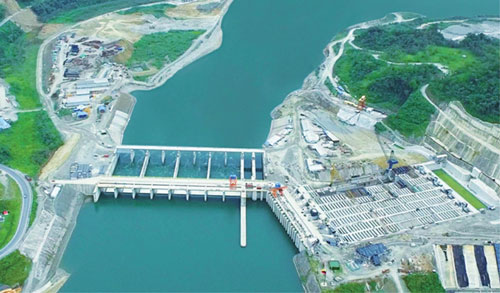Situated in the Amazon basin, 100 kilometers east of Ecuador’s capital Quito, the Coca Codo Sinclair (CCS) hydroelectric plant, a signature project in South America, and the biggest hydroelectric power station in the country has recently fallen prey to Western smears, as part of a relentless attack by Western media sources on China-proposed Belt and Road Initiative (BRI). The main difference this time is the change in focus from the alleged “debt trap” to the alleged “construction flaws.”
The allegations, claiming the project contains many crackers that may lead to its breakdown, have elicited immediate responses from officials at the Chinese Embassy in Ecuador, the participating companies, and experts, with sound evidence and a clear stance, providing a full picture of the project and others that Western media has attempted to overlook.
On the occasion of the 10th anniversary of the BRI, the Wall Street Journal on January 20 published a long article with an appalling headline and distorted information in a bid to discredit China’s overseas infrastructure projects. In the report, the CCS hydroelectric plant in Ecuador is used as an example in an attempt to support claims that it has some construction flaws.
The report claimed that “thousands of cracks have emerged in the hydroelectric plant,” suggesting that “the project could break down,” citing random experts, without providing strong evidence to back up such claims.
Chinese government officials, companies, and experts refuted this report for ignoring facts about the project.
In an exclusive interview with the Global Times on Wednesday, the Chinese Embassy in Ecuador said that the relevant reports do not give the full picture of the situation.
Regarding the partial cracks in the hydropower project, the embassy said that this problem has been investigated by an international third-party independent inspection and evaluation agency TUV SUD based in Germany, with the conclusion that it will not affect the operation and safety of the unit.
The power station will be safe within the design life of 50 years, the embassy said.
Contrary to the groundless accusation, the CCS hydroelectric plant’s contribution to improving local people’s livelihoods and the promotion of local economic development are obvious facts to all.
As the largest hydropower station in Ecuador’s history, it is a landmark project made possible by China-Ecuador practical cooperation, playing an important role in helping Ecuador’s transformation from an electricity importer to an electricity exporter, while seeing an increase in foreign exchange earnings rise.
Since the project was put into commercial operation in 2016, it has generated about 42 billion kWh of electricity so far, meeting over a quarter of Ecuador’s national electricity demand. The Power Construction Corp of China (PowerChina), the project developer, told the Global Times on Thursday.
In terms of the so-called debt issues that Western media has claimed, the engineering, procurement, and construction contract value stood at $1.98 billion, with most of the financing provided by the Export-Import Bank of China, a big relief to a country with prevailing financial difficulties.
So far, the owner’s income from power generation has far exceeded the engineering, procurement, and construction (EPC) contract cost for the project’s construction, PowerChina said.
Economically and environmentally, the commissioning and power generation of the CCS hydropower station has greatly improved Ecuador’s power supply capacity, optimized the country’s energy matrix, saved oil and gas resources, effectively reduced carbon emissions, and transformed Ecuador from an electricity importer to an electricity exporter in one fell swoop, PowerChina said.
However, by choosing to overlook the significance of the project to the regional economy and people’s livelihoods, the report selectively sidestepped these achievements and intentionally nitpicked the project, experts said.
The report forcibly pieced together issues that were not directly related, such as the relationship between the construction of the power station, the initial design, and the subsequent river erosion, giving the false impression that it is entirely the fault of Chinese companies, the Chinese Embassy further noted.
The power station is just one of many targets for Western smears against the BRI.
The Angolan Kilamba Kiaxi-Belas Municipal Planning Project, a large social housing project outside the capital of Luanda, Angola, was also targeted in the media report.
Initiated jointly by the country’s government and China’s CITIC Construction in 2008, the project came to light to meet the needs of Angola’s post-war reconstruction and people’s livelihoods, according to a statement that CITIC Group sent to the Global Times on Tuesday.
The project includes the construction of a total of 20,002 housing units and the support of municipal works, with a resident population of 120,000.
Since its completion in 2012, the current handover and occupancy rates are at 100 percent, which has greatly alleviated the urgent housing needs of the Angolan people, the company said.










